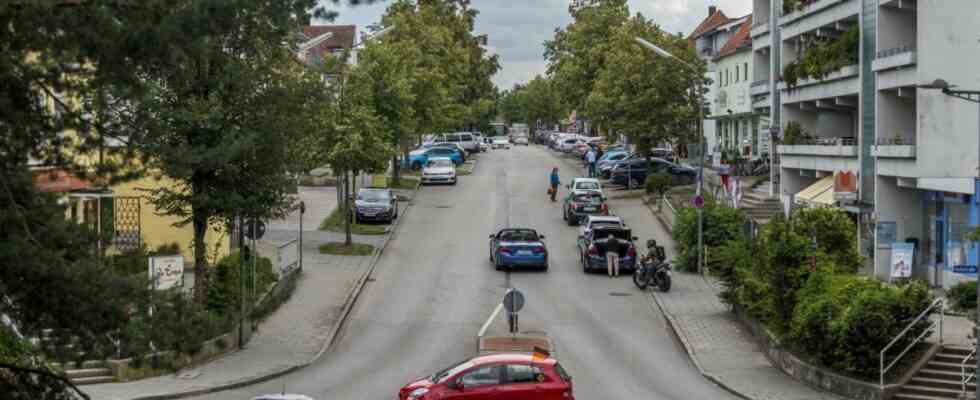Haar wants to become a city. And a city needs a proper boulevard. To this day, Leibstrasse is far from inviting people to promenade. You usually drive there, park, shop and then leave quickly. But now the municipality is once again working on redesigning the central shopping street and making it more attractive, especially for pedestrians. For example, a wider, more usable and beautiful footpath is to be created from the S-Bahn station via the station square and the previously uninviting roundabout to the part of Leibstrasse where there are many shops. This is one of the targets that the municipal council has now set for an upcoming architectural competition.
Leibstrasse is busy, but it’s often narrow for pedestrians and cars dominate. Cyclists are not really intended.
(Photo: Sebastian Gabriel)
The complaints about Leibstrasse are legendary. The otherwise assertive mayor Helmut Dworzak (SPD) failed with a redesign in the interests of the property owners. His successor Gabriele Müller (SPD) then approached the topic more broadly and managed to get the municipal council to adopt a mobility concept in 2020, according to which Leibstrasse was to be converted into a “traffic-calmed business area”. Pedestrians and cyclists should be given more space at the expense of cars. Pushing back the cars, however, met with resistance. But now Mayor Andreas Bukowski (CSU) is relying on the old ideas and is apparently making progress. Discussions were being held in the background with property owners and business people. So far, says Bukowski, we are on the right track.
The church doesn’t have any money. But she wants to tackle the plans for Leibstrasse with the help of government grants. A prerequisite for this is a so-called “integrated urban development concept” (Isek), over which the office “City, Space, Planning” broods. Before the holidays, the municipal council had to approve the detailed investigation into Leibstrasse, which the planner Martina Schneider presented. Objectives should also be formulated for the architectural competition. The municipal councils, who have been talking about a possible town council for Haar for some time now, did not have much to complain about. What is relatively new about the concept is that the unattractive crossing to the station square in particular is to be redesigned. According to the objectives, an “attractive promenade” should be created as a connection between the train station and the shopping street on the west side.
In general, the center – after a city survey of Haar you might soon be able to say City – should be upgraded and made more attractive in order to create future prospects for shops and restaurants. According to architect Schneider, the number of parking spaces should be reduced to a level that is compatible with urban planning. It’s about cars driving slower. The road should be usable for cars, buses and cyclists. Separate cycle paths, which previously could not be created continuously due to a lack of land, are no longer a priority. More space is to be created for pedestrians, especially on the west side of Leibstrasse. Green common areas are a goal and clearly visible access for pedestrians to the street, which should be easier to cross. The trees should be strengthened.
The footpath is sometimes narrow and does not run in a straight line. Accessibility is a big wish.
(Photo: private)
It won’t be as lively and lively as in the valley in Munich in the city of Haarer. But activation is the goal. The planning application for the new building on the corner of Leibstrasse and Wasserburger Strasse, where a long-lost full-range retailer is to be built, has now been approved in the town hall. Hopes are also placed on an increased designation of outdoor areas. Some time ago, when Corona help was intended for the innkeepers, the municipal council decided across factions to make outdoor gastronomy easier to do. In June, a first application was actually submitted and the decision was positive, provided that everything was done legally. It is also being considered to separate summer and winter use and to make space for restaurants where cars are parked in the cool season. There are also preliminary considerations as to how the limited street space would have to be divided up in order to allow a tram to run through Leibstrasse.
This is based on the idea of running line 21 via St.-Veit-Strasse to Wasserburger Strasse and from there to Haarer train station. Whether the passengers will then travel from the city of Munich to the city of Haar remains to be seen. Haar wants to apply for town status. The decision is made by the Bavarian Ministry of the Interior.

